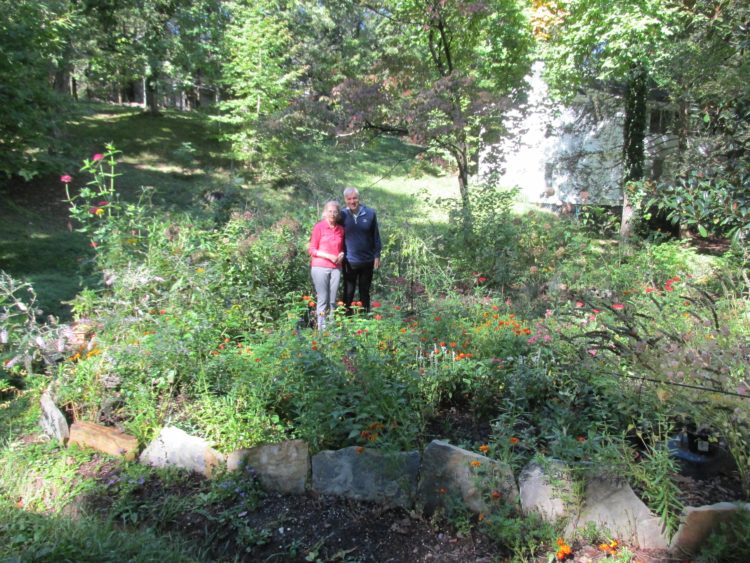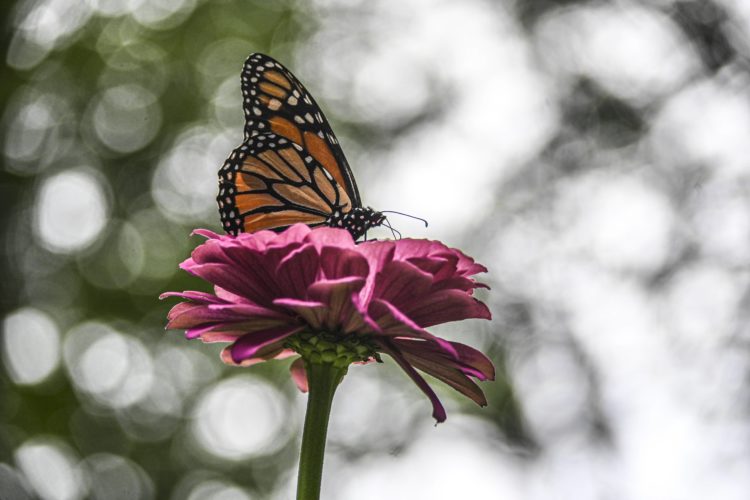On my Watch – Visiting a renown Monarch Butterfly Waystation in the Smoky Mountains of Tennessee

By Anne W. Semmes
A few weeks ago, this reporter stepped away to a summer place of her childhood in the mountains of Tennessee. My destination – the Monteagle Assembly, created on the model of the Chautauqua Institute in New York. And there, a collection of cottages welcomed me as did those tall wooden foot bridges connecting neighborhoods of families vacationing from across the country. During this trip I was privileged to meet a couple extolled for their “Monteagle Monarchs” garden.
Stephanie Smith and husband Richard “Rick” Boeth have created in their backyard a garden of Eden for butterflies. There, some 40 species have been counted, with a variety of nearly 30 plants to draw them. Add to the wonder Rick is a superb photographer documenting those butterflies in all their beauty. How the two manage and marvel at their butterfly garden is recorded in their blog, found at www.monteaglemonarchs.com.
But I was fortunate to witness it all firsthand in their garden, with their further sharing on the front porch of their charming cottage, named “Fools Rush Inn.”
The garden idea came to Stephanie on a visit to another Chautauqua in Plains, Georgia, where she met Rosalyn and Jimmy Carter. Sitting next to Rosalyn she learned about her Roselyn Carter Butterfly Trail. Thus, Stephanie was inspired to create her own butterfly garden, “to do it just right.” She then visited monarchwatch.org, “and they have the application and the list of plants that would qualify you for a Monarch Waystation.” So, Stephanie “took the list of plants, went to the nursery, and bought those plants.”
And Rick was game. He’d recently retired from a four-decade career as a photo editor/ producer. “The first 20 years was at Time Magazine in journalism, covering national affairs,” he tells, “and then the last 10 years was at CBS Television, as producer of television shows like NCIS and Blue Bloods, and other top CBS shows.” But, he adds, “I’ve always been interested in nature photography. And so, when we started the garden, it was the perfect thing to transition to. Not only for the blog, but also, I just love it.
“And the great thing about a butterfly garden is that unlike other gardens, you’re not building it so much for yourself as for the butterflies. And if you build it well for butterflies, you make it a home for all sorts of flying creatures. From the bees to the birds.”
Their monarch garden is now in its fourth year, certified as a Monarch Waystation by Monarch Watch, by the North American Butterfly Association, and Rosalyn Carter’s Butterfly Trail. But this year was an off year for Monarchs.
“The Monarch numbers are down drastically,” confirms Stephanie. “At the beginning of the summer we had no butterflies, no hummingbirds, no bees, nothing. Because it was so cold in the spring, we were two weeks late with all the plants, and that just threw everything off. And finally, we started seeing a few bees, one hummingbird, and then a butterfly or two…We saw one monarch in April passing through.”
“I think we’ve had six or seven monarchs all year,” Rick tells. “And the first few were males. And then finally at the end, just when we were fearing a shut out, we had at least two females come by. We knew one by her broken wing, and the other was more complete.”

It was time to head for their garden, now bursting with overgrown plants, but there on the monarch staple food plant, the milkweed, I spy a monarch caterpillar! “This is an earlier stage of the monarch caterpillar,” says Rick. “It goes through five growth stages, or instars.”
Rick recalls, “At first, we saw 16 caterpillars. And because the monarch is endangered, and because it’s a tough time of year, we brought four indoors. So, three out of the four have survived inside.” As for the rest, “There are many predators. Several were eaten by migrating warblers, which love caterpillars.”
On the back porch are some milkweed plants hosting two monarch chrysalises. “One is front and center,” shows Rick. “You see with the little gold necklace, and the vestige of its caterpillar skin…The day before they emerge, they eclose, the shell becomes transparent if they’re healthy. And you actually see the butterfly within”
Rick then escorts me to his computer where he shows a fascinating seven-minute video he’s made of the chrysalis, nicknamed “George,” becoming a butterfly. It can be seen on YouTube, at https://youtu.be/htOK2VWZxTA
“So,” he continues, “We’ll probably carry these chrysalises out to the garden. So, they’ll sort of hatch in the wild on the potted plants.”
The survival rate he tells is only five percent of monarch eggs “make it through to become a monarch. It takes a month. They’re defensive little creatures. And there are lots of perils.”
“Very conveniently,” adds Rick, “almost all butterflies are late risers. Early to bed, so they don’t show up till it warms up.” He believes butterflies spend a lot more time in trees than people give them credit for. “Host plants in many cases are trees for butterflies. And you’ll see them go up in trees, and you’ll actually see them resting on leaves. And so, they come down when it’s warm, like 10 in the morning generally.”
“But you get these spectacular butterflies as well,” he tells. “From the tiniest ones, which could hide behind a dime, to the giant Zebra Swallowtail, which is the state butterfly of Tennessee. And so, it becomes this great invitation to observe on a very small level, all the things that are going on in the garden. And that just opens up your opportunities for photography, and inspires you to buy these super macro lenses, and these telephoto lenses, so that you can capture all of that.”
“One of the most fascinating butterflies is the Red Admiral,” tells Stephanie. “Three years ago, he came at seven in the evening, sat on a chair, and buzzed us if we were close. It’s a territorial butterfly, we learned.” “He’s the only butterfly that comes at night,” adds Rick.
“Because there were no other Red Admirals for him to get territorial about, he got territorial with us,” Rick tells. “And he returns to the same spot to visit us, and to be territorial with us, and to perch up to three weeks. And this has happened three years in a row. A tern, if you get near their nest, they’ll like fly through your hair to scare you. This butterfly does that. And I have photos, and it’ll land on you. It’ll just sit on you and perch. And so, it’s the craziest butterfly of all, that Red.”






